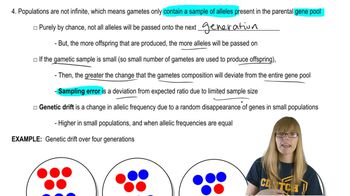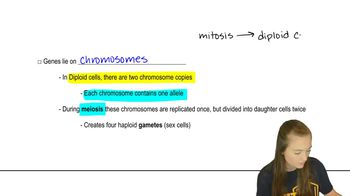The Human Genome Project has demonstrated that in humans of all races and nationalities approximately 99.9 percent of the genome sequence is the same, yet different individuals can be identified by DNA fingerprinting techniques. What is one primary variation in the human genome that can be used to distinguish different individuals? Briefly explain your answer.
Table of contents
- 1. Introduction to Genetics51m
- 2. Mendel's Laws of Inheritance3h 37m
- 3. Extensions to Mendelian Inheritance2h 41m
- 4. Genetic Mapping and Linkage2h 28m
- 5. Genetics of Bacteria and Viruses1h 21m
- 6. Chromosomal Variation1h 48m
- 7. DNA and Chromosome Structure56m
- 8. DNA Replication1h 10m
- 9. Mitosis and Meiosis1h 34m
- 10. Transcription1h 0m
- 11. Translation58m
- 12. Gene Regulation in Prokaryotes1h 19m
- 13. Gene Regulation in Eukaryotes44m
- 14. Genetic Control of Development44m
- 15. Genomes and Genomics1h 50m
- 16. Transposable Elements47m
- 17. Mutation, Repair, and Recombination1h 6m
- 18. Molecular Genetic Tools19m
- 19. Cancer Genetics29m
- 20. Quantitative Genetics1h 26m
- 21. Population Genetics50m
- 22. Evolutionary Genetics29m
15. Genomes and Genomics
Genomics and Human Medicine
Problem B.14a
Textbook Question
Select one of the hereditary conditions from either the RUSP core conditions list or the RUSP list of secondary conditions and do some online research to find the following information: The frequency of the condition in newborn infants (note any populations in which the condition is more frequent)
 Verified step by step guidance
Verified step by step guidance1
Choose a hereditary condition from the RUSP (Recommended Uniform Screening Panel) core or secondary conditions list, such as Phenylketonuria (PKU) or Cystic Fibrosis.
Research reputable sources such as the Centers for Disease Control and Prevention (CDC), National Institutes of Health (NIH), or peer-reviewed articles to find the frequency of the chosen condition in newborn infants.
Identify and note any specific populations or ethnic groups where the condition has a higher prevalence, as some genetic disorders are more common in certain populations due to founder effects or genetic drift.
Summarize the frequency data, typically expressed as the number of affected newborns per number of births (e.g., 1 in 10,000), and include any relevant demographic details.
Ensure to cross-check multiple sources to confirm the accuracy of the frequency information and understand any variations reported.
 Verified video answer for a similar problem:
Verified video answer for a similar problem:This video solution was recommended by our tutors as helpful for the problem above
Video duration:
1mPlay a video:
Was this helpful?
Key Concepts
Here are the essential concepts you must grasp in order to answer the question correctly.
Newborn Screening and the RUSP
The Recommended Uniform Screening Panel (RUSP) is a list of conditions that newborns are routinely screened for in the United States. It includes core and secondary conditions chosen based on their health impact and the availability of effective treatments. Understanding RUSP helps identify which hereditary conditions are prioritized for early detection.
Recommended video:
Guided course

History and Experiments
Frequency and Prevalence of Genetic Conditions
Frequency refers to how often a condition occurs in a specific population, often expressed as cases per number of births. Prevalence can vary by ethnicity, geography, or other demographic factors. Knowing frequency helps assess the public health impact and guides screening priorities.
Recommended video:
Guided course

Genetic Drift
Hereditary Conditions and Genetic Inheritance
Hereditary conditions are genetic disorders passed from parents to offspring through genes. These conditions can follow different inheritance patterns such as autosomal dominant, autosomal recessive, or X-linked. Understanding inheritance helps explain why certain populations may have higher frequencies of specific conditions.
Recommended video:
Guided course

Diploid Genetics

 6:51m
6:51mWatch next
Master Human Genome Composition with a bite sized video explanation from Kylia
Start learningRelated Videos
Related Practice
Textbook Question
481
views
